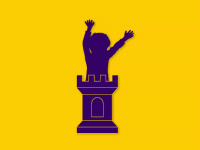Gamification: Engaging Students With Narrative
When looking at how engaged students are in playing games, it makes sense to capture some of the ideas that game designers use to engage the player. This idea of applying gaming mechanics to non-game situations is known as gamification.
What defines a game is having a goal or objective. However almost all games also have some sort of theme or story. The classic game Candyland has nothing really to do with candy. It's just about moving along a path to get to the end. The game's theme contributes to making it fun. What we learn from games is that adding narrative, storyline, a theme, or fun graphics to our lessons and activities can help students be more engaged.
Providing a Playful Context
In addition to adding to the fun of the activity, having a story can provide context for student learning. When I used the game Angry Birds to teach my students about x intercepts in math, not one student asked me, "Why do we need to learn this?" Even a fantasy context can give students purpose for their learning.
To get started, try including a paragraph with each assignment that tells a little story. "You are a spy trying to break into a government building in enemy territory. Solve these 30 math problems to gain entrance through the secret gate in the back." Create a "mission accomplished" sticker or stamp that you can place on students' papers. Look for small ways to incorporate the story while students are doing their work. Refer to each student by placing the word "Agent" in front of his or her name. "Agent Jones, can you share how you tapped into the enemy building on #5?" Place an image of a spy on your class website, project a picture of a spy onto the board, and include a graphic on the students paper. When students have completed the 30 problems, have them sneak out of the classroom at the end of the period crouched down like they are really sneaking into that building.
Expand this idea to creating a theme or story for an entire unit. Redesign the activities slightly so that they are presented in the context of the story. The story can be complete fantasy, a modification of a real-world context, or an adaptation of a popular movie or book. Add graphics from the theme to worksheets, presentation slides, or handouts, or use them as room decorations.
In a PE class, adapt the story from popular video games to give your students tasks that they must complete. They can race to save the princess rather than take three laps around the track. Jump over "pipes" and squish mushrooms in an obstacle course activity. The ultimate mission is to save the princess, and each task they do over a three-week period gets them closer to that goal. Provide a bar graph showing students how close they are to saving the princess.
Reimagining the Objective
Get students involved in the story. Ask them to write their responses in the context of the theme. Student projects could reflect this theme. Design a fantasy context where they can apply their learning. This also helps them reach higher Depth of Knowledge (DOK) levels when they apply their learning to a new situation. Biology students can include in their lab write-up how dissecting the frog provided them with clues about who was poisoning the environment around the castle. Assign students to a team chosen to travel to the fictitious planet Hupore as a league of super scientists. The gravity is half that of the earth, and the aliens living there keep borrowing the scientific equipment. How can the league of super scientists conduct their experiments under these conditions? Engage students in fantasy conversations about what is happening while they are on the planet, and allow their creativity to respond to these fictitious circumstances that keep happening to the team.
Many math games are really just playsheets where the content is the same as what would be found on a worksheet, but fun graphics and a story take place around the math problem. This model of creating playsheets out of worksheets can be applied digitally or non-digitally. While students are working on math problems, play video game-style music in the background. Include slides with cartoon graphics of the character that students are trying to pull from a deep pit that he fell into. The more math problems the students answer correctly, the higher they pull him out of the pit. Advancing to the next slide shows the character climbing the rope higher.
The Role-Playing Student
Think of ways to recognize student participation that is reflective of the theme. The student plays a role in the story. Perhaps have them create avatars who earn rewards as they complete missions. Their paper avatar on the wall can earn things such as a cell phone that the student can glue onto their character. For a space theme, have students gain new titles such as "Commander Garcia."
Providing a story with the assignments makes the tasks more fun, creates a context for student learning, and makes your students active players in their own learning. Having a narrative is a great way to get started with gamification.
